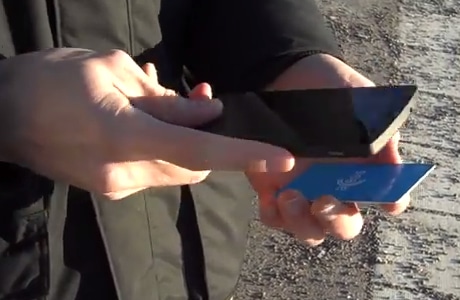
Swedish startup Fidesmo has developed a service that lets NFC phone owners replace multiple, physical transport passes with a single contactless card.
New funds can be added to each service operator’s “card” on the go using a Fidesmo mobile app — eliminating the need to visit a physical agent to top up their balance and solving “the pain point of communicating with a contactless card after issuance”.
Using Fidesmo, cards from participating service operators are downloaded over the air to the user’s phone and then transferred on to the Fidesmo contactless card by touching it to the phone. The balance on each operator card can then be updated when new funds are purchased via the app, again by simply touching the Fidesmo contactless card to the phone.
When travelling, the Fidesmo app allows the user to select the correct card for the operator of the transportation service they will be using and then touch their contactless card to the operator’s reader in the usual way.
“The data is never really stored in the phone, but just passes through the phone to the card, so the communication is actually from the card all the way to the back end,” Fidesmo CEO Mattias Eld — a former TSM product manager at Ericsson — explains to NFC World+.
“The card for the correct operator is selected once and then stays selected until a new card is selected. So, if you are in the same city, you don’t need to reselect using your mobile phone all the time, you just do it once.
“When you actually use the card on board public transport, or whatever you use it for, the phone is not involved at all. The phone is only involved when you download the credentials to the card and you download those using NFC.
“If you compare it to what you can do today with mobile phones and buying tickets, it is not that easy to buy tickets with the phone. With this, you will be able to do it instantaneously and you can use the system straight away, without having to wait for input from the mobile network operators.”
Eld says he is not convinced people will want to “point their mobile phones at everything”, adding the card format is the one that most people feel comfortable using.
“People are used to using a card and, for some situations, I think the card is the most suited form factor that we have had for quite some time now and we have gotten used to it, so it makes more sense to use it. In many cases, it just makes sense to have your credentials stored somewhere else other than on your phone.
“The fact that people are comfortable with using cards already is a very important part of it. This is what people are using now and we are just making it a little bit easier to buy tickets, but the way you use it is exactly the same. It is a very minimal change but a step in the right direction; a very convenient direction.”
Fidesmo envisages a wide, and global, range of uses for their card, with cafe loyalty cards seen as a good fit alongside ticketing. Open APIs for developers are now open to allow them to build new services.
A video produced by Fidesmo shows how the service can be used to improve the customer experience:
“We expect to have the first live installation during this year,” Eld says. “We think that this can be a global service and we have a global ambition. For developers to sign up, they can be global. They can sign up anywhere, we can sell the card anywhere. Anyone can buy our card and start using it — there are no country restrictions on that.”
Learn more about Fidesmo in the NFCW Expo.
Very good ideas!